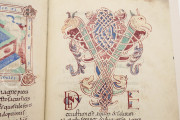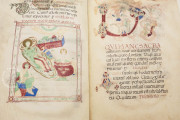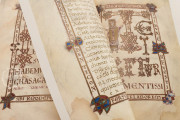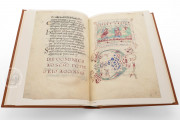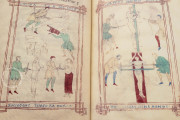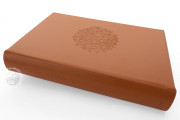The Sacramentary of Warmund is an illuminated Christian liturgical manuscript containing the prayers said by the celebrating priest at Mass through the liturgical year and prayers reserved for the use of bishops in special ceremonies. It was made at the behest of Warmund, Bishop of Ivrea, presumably for his personal use and for the use of his successors. Exactly when and for how long during Warmund's episcopacy (966-his death) it was created is a matter of debate; it is generally dated to ca. 1000. With sixty-two miniatures, it is the most extensively illuminated sacramentary of its time.
The manuscript's miniatures depicting the consecration or anointing of bishops and kings (fols. 2r, 8r, and 160v) are justly famous, but it also deserves renown for its biblical scenes rarely found in early medieval art, such as the Naming of John the Baptist (fol. 88r).
Warmund Pictured in His Book
Among the sacramentary's many miniatures are two that depict the bishop who patronized its creation: the Blessing of the Chrism (fol. 52v) and the Crucifixion and Entombment of Christ (fol. 57v). Warmund is shown in the first with a square halo, indicating that he was understood as holy even while living. In the Crucifixion scene, he is shown—the smallest figure in the scene—at the foot of the cross in his liturgical vestments but without a halo, thus humbling him in the presence of the biblical figures.
Bright Color and Gold
The work of at least five painters, the miniatures are in a drawing style, with coloration in green, red, blue, teal, ocher, and gold leaf, sometimes applied in an apparently random manner. For example, the two depictions of Warmund show him once with green hair and once with blue hair. The miniatures are framed by borders, many with interlace knots at the corners and with explanatory text and prayers within the frames.
Clear, Legible Writing
The main text is written in Caroline Minuscule, with rubrics in display script. The texts in the miniatures' frames are in Rustic Capitals. Each liturgical service is introduced by an initial in colored inks, often composed of interlace motifs.
A Page of Gold
The Te Igitur page (introducing the prayers said at the preparation of the Eucharistic elements in the Mass) is a tour-de-force, the first prayer beginning with gold interlace letters that diminish in scale, followed by further gold text inspired by Square Capitals within a frame with six interlace knots and further text in gold display script (fol. 13r).
Warmund's Sacramentary Today
Warmund, who patronized the production of at least five liturgical manuscripts, continued to be considered a saintly figure after his death, and he was beatified in 1857. His sacramentary remains in the library of the cathedral for which it was created, cherished as much as a contact relic with its patron as an object of historical import.
We have 1 facsimile edition of the manuscript "Sacramentary of Warmund": Sacramentarium Episcopi Warmundi facsimile edition, published by Priuli & Verlucca, editori, 1990
Request Info / Price






